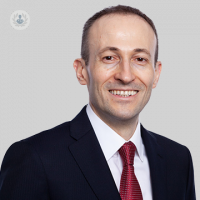Ask an expert: fibroids
Autore:Mr Pandelis Athanasias, a highly esteemed consultant gynaecologist with a vast experience in the treatment of fibroids explains what fibroids are, why they develop and what treatment options are available.
What are fibroids?
Fibroids (sometimes referred to as uterine myomas or leiomyomas) are benign growths of different sizes, which form in or around the womb. The majority of women with fibroids are unaware of it, as only around 1 in 3 will experience symptoms.
Why do fibroids develop?
The exact reason fibroids develop is uncertain, however, most gynaecologists generally agree that it is linked to increased oestrogen levels. What we do know is that some risk factors that can increase the likelihood of developing uterine fibroids. These include:
- use of birth control
- vitamin D deficiency
- getting your period at a young age
- family history of fibroids
What are some prevalent symptoms of fibroids?
While symptoms do not always present themselves, the magnitude to which a woman can exhibit the key symptoms can range from mild to severe and can vary from person to person.
The most common symptoms of fibroids include:
- prolonged, painful or heavy periods
- bleeding between mensuration
- abdominal pain or discomfort
- back pain
- pelvic pain
- constipation
- frequent urination or difficulty passing urine
- pain during sex
- a firm mass, often located near the middle of the pelvis
How are fibroids diagnosed?
Fibroids are often found during a physical examination of the pelvic and abdominal area. Doctors will take the patient’s complete medical history and may also perform some of the following diagnostic procedures:
Transvaginal ultrasound: A small instrument called a transducer is carefully placed inside the vagina. It uses sound waves to assess the shape, size and consistency of the uterus. It can confirm the diagnosis and map the measurements of the fibroids.
Magnetic resonance imaging (MRI): This is a non-invasive procedure that creates a 2D representation of the womb. It is used to evaluate the size and location of the fibroids in order to help determine the appropriate form of treatment.
Hysterosonography: This test uses a saline solution to distend (swell) the uterine cavity. This helps to provide an ultrasound which accurately shows the presence of submucosal fibroids
Hysteroscopy: A small telescope called a hysteroscope is inserted through the vagina. It provides a visual examination of the cervix canal and the uterus. It is the gold standard investigation for the diagnosis (and treatment) of submucosal fibroids. In the vast majority of cases, it can be performed with or without local anaesthetic.
What are my treatment options for fibroids?
Treatment options for fibroids include both medical and surgical options.
There are several different types of medication that can be used to help with fibroid treatment in the UK. Medications will not eliminate fibroids, but they do have the ability to shrink them or slow down their growth velocity.
That being said, medication can be less effective for larger fibroids.
Surgical treatments available for fibroids include:
Laparoscopic myomectomy
This procedure involves removal of the fibroids, while leaving the uterus in place. Instruments are inserted into the abdomen through three or four very small incisions and the fibroids are removed from the uterus. The surgeon is able to view the abdominal area on a monitor through a small camera attached to one of the instruments.
It is the preferred treatment for intramural (fibroids growing inside the uterine muscle) and subserosal (fibroids protruding outside the uterine surface) fibroids, as it permits rapid recovery, a shorter hospital stay, less pain after the operation and a quick return to regular daily activities.
Open Myomectomy
This is a traditional surgery with a large incision in the abdomen. It is suitable for women with multiple or very large fibroids and only when minimally invasive techniques are not appropriate.
Hysterectomy
This involves removal of the uterus, which contains the fibroids. Hysterectomy may be performed via keyhole surgery or traditional open surgery.
Hysteroscopic resection
This is a procedure where hysteroscope (a thin telescope) and small surgical instruments are used to remove submucosal fibroids from inside the womb. No incisions are needed because the hysteroscope is inserted through the vagina and into the womb. The procedure is often carried out under general anaesthetic and patients usually go home on the same day.
Hysteroscopic morcellation
Experienced gynaecologists can also remove fibroids by carefully placing a hysteroscope inside the womb and using a tissue removal system to cut away and remove the fibroid tissue. The procedure can be carried out under general or local anaesthetic and patients can go home the same day.
Uterine artery embolisation (fibroid embolisation)
This is a minimally invasive procedure, during which small particles are directed into the arteries, which supply the uterus with blood and will cut off the blood supply to the fibroids. As a result, the fibroids shrink and die. This is a very effective technique, but requires an MRI beforehand in order to decide whether the fibroids are suitable for embolisation. It is performed under local anaesthetic by an interventional radiologist and is a day case procedure.
If you would like to book a consultation with Mr Athanasias, simply visit his Top Doctors profile today.



